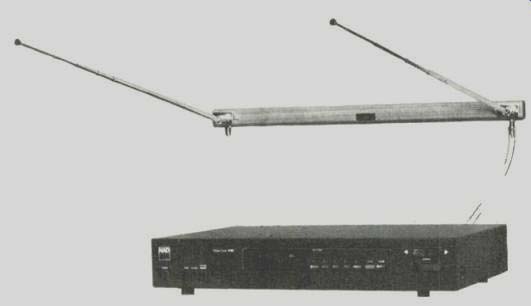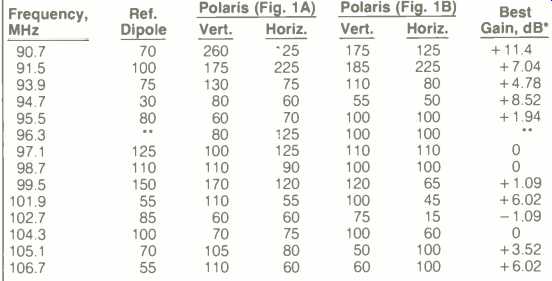
Company Address: P.O. Box 51, Beverly, Mass. 01915.
The problem of what to do if you can't install a good outdoor FM antenna but still want reasonably good FM reception is an old one. From time to time, various inventors and experimenters have come up with solutions to this problem, some of them simple, some of them complex and expensive.
An indoor FM antenna that I recently tested falls into the simple but highly effective category. Developed for and marketed by Dennesen Electrostatics, the Polaris indoor FM antenna, with a suggested retail price of $40, is nothing more than a pair of monopole antenna elements, mounted at opposite ends of a 19-inch piece of wood (having a 1-inch cross-section). Each mono pole element can be extended to a maximum length of around 39 inches, and each is terminated in a standard F-type coaxial connector. Actually, only one of these elements is intended to be an "active" antenna; the other element serves as a passive reflector.
The Polaris antenna was designed to be mounted on a wall at a height of about 6 or 7 feet, with its telescoping rods projecting into the room. Figure 1 shows two configurations that the manufacturer feels will give good results. In either, the rods can be oriented vertically or horizontally. With many FM stations now using circular polarization, vertical orientation usually works out best; it is also the easiest to implement in a typical listening room.
Obviously, the possible orientations are almost infinite, since each rod can be pivoted to any angle and the lengths of the active and passive elements can also be adjusted for optimum reception. The instructions say to keep the elements parallel to each other and perpendicular to the arriving signal. The passive, unconnected element should be nearer to the station and shorter than the active one connected to the tuner. To receive stations from the opposite direction, the cable can be moved to the opposite element, and the lengths of both elements can be readjusted.

Table 1--Signal strength (uV). Dennesen Polaris vs. standard dipole antenna.
*Best figure obtained for any orientation as compared with optimized dipole
orientation. **Signal strength of this station could not be reliably read due
to interference from other stations' signals nearby on the dial.

Fig. 1--Two of the possible orientations for the Dennesen Polaris; these can
be used horizontally or vertically, depending on station polarization.
In my tests, however, I confined my self to four configurations, the horizontal and vertical versions of those shown in Fig. 1. The signal received from the Polaris was compared to that from a standard dipole antenna, with both antennas oriented for best reception of each station. The results are given in Table I. Measurements were made with a Blonder-Tongue FSM-2 field strength meter. which covers the entire IFM frequency band (as well as the VHF and UHF TV frequencies). The mete is calibrated directly in micro volts for its input impedance of 75 ohms. The Polaris also has a 75-ohm output, and most FM tuners and receivers have 75-ohm antenna inputs.
(Matching transformers are available for tuners having only 300-ohm inputs.) It is apparent from Table I that for almost every incoming FM signal to which I tuned, there was one available configuration of the Polaris which provided some gain, compared to the signal strength obtained using the standard dipole. Over and above the mere gain exhibited by the Polaris antenna, I noted that proper positioning of the antenna resulted in considerably less multipath interference with some of the more troublesome stations in my area.
In addition, there were at least two in stances where, in the crowded FM band in which my tests were conducted. I was able to separate two stations that interfered with each other when I tried to tune to them using the standard dipole. On the basis of these results. I would conclude that, as simple as the Dennesen Polaris indoor FM antenna seems to be, it may well provide a solution for the many FM listeners who are having trouble with FM reception in their homes or apartments and who, for one reason or another, are unable to mount a good directional antenna on their rooftops.
-Leonard Feldman
Also see:
Audioprism 7500 Indoor FM Antenna (Auricle, Dec. 1989)
Terk 9600 Pi FM Antenna (Feb. 1989)
FM Specifications Revisited by Leonard Feldman (April 1978)
FM Fidelity: Is The Promise Lost? (March 1985)
The Problem with FM (March 1985)
= = = =